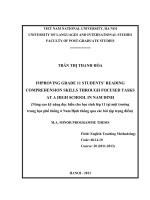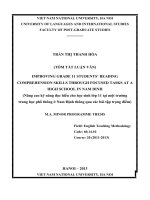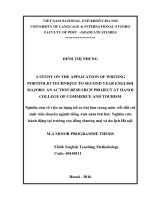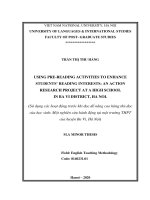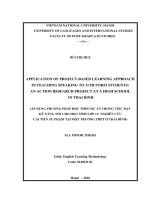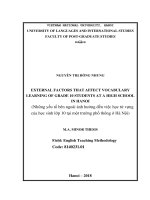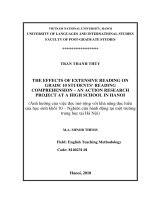The effects of extensive reading on grade 10 students’ reading comprehension – an action research project at a high school in hanoi
Bạn đang xem bản rút gọn của tài liệu. Xem và tải ngay bản đầy đủ của tài liệu tại đây (661.49 KB, 96 trang )
VIETNAM NATIONAL UNIVERSITY, HANOI
UNIVERSITY OF LANGUAGES AND INTERNATIONAL STUDIES
FACULTY OF POST-GRADUATE STUDIES
****************
TRẦN THANH THÚY
THE EFFECTS OF EXTENSIVE READING ON
GRADE 10 STUDENTS’ READING COMPREHENSION
– AN ACTION RESEARCH PROJECT AT A HIGH
SCHOOL IN HANOI
(Ảnh hưởng của việc đọc mở rộng với khả năng đọc hiểu
của học sinh khối 10 – Nghiên cứu hành động tại một
trường trung học tại Hà Nội)
M.A. MINOR THESIS
Field: English Teaching Methodology
Code: 8140231.01
Hanoi, 2018
VIETNAM NATIONAL UNIVERSITY, HANOI UNIVERSITY OF
LANGUAGES AND INTERNATIONAL STUDIES FACULTY OF
POST-GRADUATE STUDIES
****************
TRẦN THANH THÚY
THE EFFECTS OF EXTENSIVE READING ON
GRADE 10 STUDENTS’ READING COMPREHENSION
– AN ACTION RESEARCH PROJECT AT A HIGH
SCHOOL IN HANOI
(Ảnh hưởng của việc đọc mở rộng với khả năng đọc hiểu
của học sinh khối 10 – Nghiên cứu hành động tại một
trường trung học tại Hà Nội)
M.A. MINOR THESIS
Field: English Teaching Methodology
Code: 8140231.01
Supervisor: Dr. Vũ Thị Thanh Nhã
Hanoi, 2018
DECLARATION
I certify my authority of the Study Project Report entitled “The effects of extensive
reading on grade 10 students’ reading comprehension at a high school in Hanoi”
is the result of my own research in the fulfillment of the requirement for Degree of
Master of Arts at the Faculty of Post Graduate Studies – University of Languages
and International Studies, Hanoi. I commit that this thesis has not been submitted
anywhere for any degree.
Trần Thanh Thúy
Hanoi, 2018
ACKNOWLEDGEMENTS
On completing this graduation paper, I would like to thank many people for their
invaluable help during the conduct of the research. First and foremost, I would like
to express my deep gratitude to my supervisor Dr. Vũ Thị Thanh Nhã, for her
critical and timely feedback, her constant understanding and her unfailing
encouragement, without all of which I would not have been able to complete this
paper.
I would like to take this opportunity to express my special thanks to Dr. Lê Văn
Canh, from the Faculty of Post Graduate studies, University of languages and
international studies for his interesting and informative lectures that suggested the
idea for this study.
I would also like to say the sincerest thanks to 48 students at class 10 C1, Vietnam –
Poland high school who have participated in the study. Their participation has been
crucial to the completion of the research.
Last but never least, my sincere thanks to my family and friends whose support has
been a great significance to the success of my thesis.
ABSTRACT
The role of reading in second and foreign language acquisition has been widely
acknowledged. Among different approaches to teaching and learning reading, extensive
reading has received worldwide acceptance from researchers and educators for its many
benefits to the learners. Despite a wealth of research data in this area, there is a significant
gap in insight into how extensive reading is practiced in the context of Vietnam,
particularly at Vietnam – Poland high school. In an attempt to improve the reading
comprehension for grade 10 students, the researcher decided to carry out an action research
with 48 students at class 10C1, Vietnam – Poland high school in 17 weeks. A Questionnaire
and two tests were used to explore student‟s attitudes towards reading extensively and its
effectiveness. The results of the study revealed that the program had positive effects on
students‟ reading comprehension. Besides, through the program, most students indicated
that they improved their writing, speaking skills, and mastery of vocabulary and grammar
structures. Most of them also agreed that they gradually created reading habits in their free
time. It is hoped that the findings from the study will benefit not only researchers and
teachers interested in reading but also students by raising their awareness of their own
practice.
Table of Contents
DECLARATION
ACKNOWLEDGMENTS
ABSTRACT
CHAPTER I: INTRODUCTION........................................................................... 1
1.2. AIMS OF THE STUDY AND RESEARCH QUESTIONS............................................. 2
1.3. SIGNIFICANCE AND SCOPE OF THE STUDY......................................................... 3
1.4. OUTLINE OF THE THESIS................................................................................... 3
CHAPTER II: LITERATURE REVIEW.............................................................. 5
2. 1. READING AND READING COMPREHENSION...................................... 5
2.1.1. OVERVIEW OF READING AND READING COMPREHENSION................................. 5
2.1.2. THE ROLE OF READING IN SECOND LANGUAGE LEARNING................................ 6
2.2 EXTENSIVE READING.................................................................................. 6
2.2.1. DEFINITION OF EXTENSIVE READING................................................................ 6
2.2.2. EXTENSIVE READING AND READING COMPREHENSION.....................................7
2.2.3. EXTENSIVE READING AND INTENSIVE READING............................................... 8
2.2.4. PRINCIPLES OF EXTENSIVE READING................................................................ 9
2.2.5. BENEFITS OF EXTENSIVE READING IN SECOND LANGUAGE LEARNING............12
2.3. READING MATERIALS.............................................................................. 14
2.3.1. GRADED READERS......................................................................................... 14
2.3.2. UNSIMPLIFIED TEXTS..................................................................................... 16
2.4. READING ATTITUDES................................................................................ 17
2.5. PREVIOUS STUDIES................................................................................... 18
2.6. SUMMARY..................................................................................................... 20
CHAPTER III: METHODOLOGY..................................................................... 21
3.1. RESTATEMENT OF RESEARCH QUESTIONS....................................... 21
3.2. PARTICIPANTS............................................................................................. 21
3.3. SETTING........................................................................................................ 21
3.4. RESEARCH DESIGN................................................................................... 22
3.4.1. DEFINITION OF ACTION RESEARCH................................................................. 22
3.4.2. RATIONALE FOR USING ACTION RESEARCH..................................................... 23
3.4.3. BENEFITS AND LIMITATIONS OF AR................................................................ 24
3.4.3.1. Benefits of action research......................................................................... 24
3.4.3.2. Limitations................................................................................................. 25
3.4.3.3. Students‟ and teachers‟ role....................................................................... 26
3.4.3.4. Action research procedures......................................................................... 26
3.4.3.5. Action research procedures of the current study......................................... 28
3.5. READING MATERIALS.............................................................................. 29
3.6. DATA COLLECTION INSTRUMENTS..................................................... 31
3.6.1. TESTS............................................................................................................. 31
3.6.2. QUESTIONNAIRES.......................................................................................... 32
3.6.3. WEEKLY REPORT................................................................................................................... 32
3.7. DATA ANALYSIS....................................................................................................................... 32
3.7.1. Mean score.................................................................................................................................. 33
3.7.2. Negative item and reverse scoring........................................................................................ 33
3.7.3. Size of standard deviation (SD)............................................................................................. 33
3.8. SUMMARY..................................................................................................... 34
CHAPTER IV: FINDINGS AND DISCUSSION................................................ 35
4.1. TO WHAT EXTEN DOES THE EXTENSIVE READING HELP STUDENTS IMPROVE
THEIR READING COMPREHENSION?....................................................................................... 35
4.1.1. PRE-TEST RESULT........................................................................................... 35
4.1.2. POST – TEST RESULT...................................................................................... 36
4.2. RESEARCH QUESTION 2: WHAT ARE THE STUDENTS’ ATTITUDES TOWARDS
THE EXTENSIVE READING?........................................................................................................ 37
4.2.1. DATA COLLECTED FROM THE WEEKLY REPORTS............................................. 37
4.2.1.1. The students‟overall attitude towards reading materials............................37
4.2.1.2. The students‟opinions on the level of difficulty of reading materials.........39
4.2.2. DATA COLLECTED FROM THE QUESTIONNAIRES.............................................. 41
4.3. DATA COLLECTED FROM TWO OPEN – ENDED QUESTIONS.............................49
4.4. EVALUATION OF EXTENSIVE READING PROJECT..........................51
4.4. SUMMARY..................................................................................................... 52
CHAPTER V: CONCLUSION............................................................................. 54
5.1. CONCLUSION................................................................................................... 54
5.2. RECOMMENDATIONS....................................................................................... 56
5.2.1. RECOMMENDATIONS FOR SCHOOLS AND TEACHERS....................................... 56
5.2.2. RECOMMENDATIONS FOR LEARNERS.............................................................. 57
5.3. LIMITATIONS AND SUGGESTIONS FOR FURTHER STUDIES..............................58
REFERENCE
APPENDICES
LIST OF ABBREVIATIONS
AR:
EFL:
ER:
ERP:
ESL:
ESP:
GE:
RC:
Action research
English as a Foreign Language
Extensive reading
Extensive reading project
English as a Second Language
English for Specific Purposes
General English
Reading comprehension
LIST OF TABLES AND FIGURES
Figure 1. Tri – component of reading attitudes
Figure 2. Action research process
Table 4.1.1. The reading comprehension pre – test result
Table 4.1.2. The reading comprehension post – test result
Table: 4.2.1.1: Students general feelings about the books
Table 4.2.1.2. The students‟opinions on the level of difficulty of reading materials
Table 4.2.2 (a): Students „attitudes towards the extensive reading project (beliefs)
Table 4.2.2 (b): Students‟atitudes towards the extensive reading (feelings)
Table 4.2.2 (c): Students‟attitudes towards the extensive reading project (intention)
CHAPTER I: INTRODUCTION
The current study was conducted to explore the effects of extensive reading on
reading comprehension of grade 10 students at a high school as well as their
attitudes towards reading in English. This chapter including five sections presents
the background to the study and the statement of the problems, the aims, the scope
and the significance of the study. The outline of the thesis is also stated in this
chapter.
1.1. BACKGROUND TO THE STUDY
Nowadays, English has become one of the most important languages in the
world. Especially in the globalization trend, it is spoken as a second language and
an official language in many countries, and as a foreign language in the global
world as well. Almost all the people from many different countries around the world
use it to communicate. At high schools in the whole country, English is now a
compulsory subject for all students. In view of this, the curriculum plan and syllabi
of the high school education in Vietnam have focused on English learning. In
language learning, reading is a very important part among such other language skills
as speaking, listening, and writing. Especially, in EFL/ESL environment, reading is
the basis of instruction in all aspects such as writing, listening, developing
vocabulary and acquiring grammar. With strengthened reading skills, ESL/ EFL
readers will make greater progress and attain greater development in all academic
areas (Anderson, 2003). Additionally, reading is a crucial skill in universal learning
and communication. In this sense, reading ability has always been viewed as critical
to academic success (Carrell, 1991; Grabe & Stoller 1997, 2002). Furthermore,
Nation (1997) states that success in reading and its associated skills makes learners
come to enjoy language learning and value their study of English. It is obvious that
reading helps students become better readers. Research in both L1 and L2 shows
that we learn to read by reading. The more our students read, the better reader they
would become. And the more vocabulary they know, the better they can read. In
addition, Krashen (1988) posited that the best way to
1
improve reading is by reading. Research has shown reading helps facilitate reading
comprehension, reading speed, and reading ability, develop reading fluency, and
improve vocabulary learning (Day & Bamford, 1998). Having read about the
benefits of ER, the author wants to find out how ER can affect the grade 10 students
in their English learning, especially reading comprehension.
Like many other high schools in Vietnam, the researcher‟s high school has
been applying the English curriculum promulgated by the Ministry of Education
and Training (MOET), and prescribed to all high schools nationwide since 2006.
Tiếng Anh 10, one in the series of the prescribed textbooks, consists of 16 themebased units. Each unit comprises five sections including four language skills as
reading, listening, speaking, writing and language focus. Teaching and learning time
for each section is 45 minutes; therefore, a total of 135 minutes per week is
scheduled for all language skills including language focus and vocabulary
instruction. Students have to read a texts ranging from 250 to 300 words in length
and then do the reading comprehension tasks. With only one reading text to read
each week, the amount of reading is somewhat too limited to help students become
good readers. And the students rarely have time for extra reading materials in class
because of the tight schedule. Additionally, poor vocabulary knowledge also causes
difficulties to students and they often get stuck when they read and do the reading
exercises very slowly. Besides, the test result is low and a concern of not only
students but also teachers to find a way to help students solve this problem. This
situation leads to the assumption that the learners‟ reading comprehension is weak
due to limit reading materials and practice. Therefore, in this study, I would like to
apply an extensive program to help my students improve their reading
comprehension ability.
1.2. Aims of the study and research questions
This action research aims to study the possible changes in grade 10 students‟
reading comprehension ability through extensive reading at a high school and
2
provide practitioners with suggestions and recommendations for future extensive
reading programs.
In particular, it aims at the following questions:
1. To what extent does extensive reading (ER) help students improve their
reading ability?
2. What are students‟ attitudes towards the extensive reading program?
1.3. Significance and scope of the study
The
action
research
originates
from
the
learners‟
poor
reading
comprehension, one of the most important reading skills. Meanwhile, reading itself
plays an important role among the four skills (reading, listening, speaking and
writing) to ESL learners. As mentioned above, reading comprehension (RC) is very
important to the students at a high school. Therefore, helping students to improve
their reading comprehension is a necessity. What is more, as elaborately presented
above, this study aims to develop students‟reading habits outside class through ER.
By this way, ER helps students enrich their vocabulary and reading rate. ER has
been proved to bring many effects on students‟ RC in many countries (Japan, The
USA, India, Singapore, etc.) by different researchers whereas no similar program
has been conducted at Vietnam – Poland high school. This encourages the author to
conduct this research study. It is hoped that the findings of the study will provide
convincing information about the ways to run extensive reading program (ERP), the
value of ER on EFL learning, ESL students as well as better understanding about
action research.
1.4. Outline of the thesis
This thesis comprises five chapters. A brief summary of the content of each chapter
is described as follows
Chapter 1: Introduction, presents the background to the study including the
statement of the problems, the aims, the scope as well as the significance of the
study. The outline of the thesis is also stated in this chapter.
3
Chapter 2: Literature review, discusses academic view points on ER. It
summarizes the most critical ideas about the role of extensive reading in reading
comprehension and its principle, benefits, reading attitudes; graded readers as the
reading material of the present study. Previous studies related to the current study
are also reported in this chapter.
Chapter 3: Methodology, describes the methodology of the study, provides the
readers with definition of action research, procedures of action research, detailed
description of the participants and data collection instruments.
Chapter 4: Findings and discussion, presents the results of the study. It also
provides discussion about the results.
Chapter 5: Conclusion is expected to provide final conclusion to the study, the
limitations of the study as well as suggestions for further study.
4
CHAPTER II: LITERATURE REVIEW
This chapter will explore some theoretical background to the study. It firstly
discusses the concept of reading and reading comprehension and later discusses the
concept of extensive reading and reading attitudes. In addition, the chapter will also
review the concept of reading materials and reading attitudes.
2. 1. READING AND READING COMPREHENSION
2.1.1. Overview of reading and reading comprehension
Reading is a process undertaken to reduce uncertainty about the meanings a
text conveys. It is also the process resulting from a negotiation of meaning between
the text and its reader. The knowledge, expectations, and strategies a reader uses to
uncover textual meaning all play decisive roles in the way the reader negotiates with
the text's meaning.
Among reading skills, reading comprehension (RC) is an important part in
teaching and learning a foreign language in general and reading in particular.
Someone has said that it is the act of understanding what you are reading and is an
intentional, active, interactive process that occurs before, during and after a person
reads a particular piece of writing. RC has been defined in different ways by
different researchers.
Anderson and Pearson (1984) defines RC in terms of how language is “A
schema-theoretic view of the basic processes in reading comprehension” in which
schemas or packages of background knowledge were represented in a series of
models called interactive models of reading comprehension (as cited in Reutzel,
2008). Besides, Richards et al. (1992) states that RC is best described as an
understanding between the author and the reader. RC is considered as the process of
decoding language to think or work out the meaning of a reading by Davies and
Whitney (1979).
5
2.1.2. The role of reading in second language learning
It is a well-known fact that when there were no televisions or computers,
reading was one of primary leisure activities. Reading helps in mental development
and is known to stimulate the muscles of the eyes. Additionally, it is an activity that
involves greater levels of concentration and adds to the conversational skills of the
reader. It is observed that children and teenagers who love reading have
comparatively higher IQs. So, reading skills are essential for not only students‟
academic success but also their social and business advancement. Walter (2004)
stated that reading in a second language calls for fast, automatic word decoding and
access to the mental lexicon (dictionary); this means working on building speed and
fluency and on learning to recognise at least 10,000 words in the new language. By
reading, students got familiar with many topics, acquired a lot of new words and
were easy to deal with a number of reading texts without difficulty. Students would
gradually be more confident about the topics in the text and could read and write
well. Hoang et al. (2006) considered reading as the most effective means of
improving students‟ language competence (as cited in Thanh, 2009).
2.2 EXTENSIVE READING
2.2.1. Definition of extensive reading
A lot of trials have been made on working out a thorough definition of ER.
Among them is the one by Lewis and Hill (1992) in which extensive reading means
that “students have general understanding of the text without necessary
understanding every word”. Obviously, this definition fails to help learners imagine
the whole picture of ER since only one aspect of it is shed light on, that is, the
purpose of ER (general understanding). The definition by Carrel and Carson (1997)
which says that “extensive reading generally involves rapid reading of large
quantities of material or long reading” concerns with only the length of the reading.
Bamford and Day (1997) defined ER as an approach to foreign language teaching in
general, and to the teaching of foreign language reading in particular.
6
To support the opinions of Bamford and Day (1997), Bruton (2002) said that
ER can apply to a number of "amounts": The amount of new text that is read; The
breadth of reading as in "wide reading" (Stoller and Grabe, 1993, p. 31) as opposed
to "narrow reading" around a particular topic or particular genres of text (Schmitt
and Carter, 2000, p. 5); The amount of text consumed, but not necessarily new text,
as in "repeated reading" (Samuels, 1997, p. 377); and the amount of time spent
reading.
The definition that seems to be more satisfying than those mentioned above is
the one introduced by Robb and Susser (1989). They defined ER as a language
teaching/learning procedure because it was reading “(a) of large quantities of
material or long text; (b) for global or general understanding; (c) with the intention
of obtaining pleasure from the text; (d) individualized, with students choosing what
they want to read; (e) the books are not discussed in class”.
2.2.2. Extensive reading and reading comprehension
A number of studies have demonstrated reading comprehension gains from
extensive reading. Sims (1996) carried out a study on two groups of Taiwanese
university freshmen, where one group was exposed to extensive reading while the
other group was exposed to skill-based reading. The extensive group scored better
on written recall protocols and on reading comprehension tests. Likewise, Hitosugi
and Day (2004) found improvements in their participants‟ reading ability over the
period of 10 weeks. They studied one extensive reading class and another regular
reading class, which did not have the extra extensive treatment. The reading
comprehension of both groups was pre- and post-test. The study found that the
extensive reading group outperformed the traditional group on a reading ability test.
Mason and Krashen (1997) found a similar effect for general language learning,
with their extensive reading groups in Japan making greater gains on a 100-item
cloze test than traditionally-taught groups.
Other studies have found positive results for extensive reading, although
various methodological problems lower the rigor of these studies. For example,
7
Robb and Susser (1990) found some advantage for an extensive reading
methodology over a skill-building one, in terms of understanding important facts
and guessing vocabulary from context, but not for getting the main idea or making
inferences. However, the two methodologies were not clearly differentiated from
each other and were similar in many ways. Bell (2001) found that an extensive
reading group outperformed an intensive reading group after a two-semester period,
but he questions the reliability of all of his tests.
2.2.3. Extensive reading and intensive reading
The discussion of ER often requires some attention to intensive reading as
well, since the former is believed to help fix a number of problems encountered
during the practice of the latter, and the two of them are sometimes held in
opposition. Intensive reading is a process whereby students read materials which is
usually above their linguistic level. The material usually contains a large number of
unknown vocabulary items and grammatical forms that are difficult for, or unknown
to, the learner. The purpose is usually to have learners explicitly study new
vocabulary and use a host of reading skills such as skimming, scanning, and
guessing meaning from context. Bruton (2002) characterizes intensive reading as
“having comprehension and language-focused tasks completed communally by the
whole class.” (para. 2). Brown (2007), similarly, states that intensive reading is
usually “a classroom-oriented activity in which students focus on the linguistic or
semantic details of a passage. Intensive reading calls students' attention to
grammatical forms, discourse markers, and other surface structure details for the
purpose of understanding literal meaning” (p 373). Another similar but useful
description is given by Bamford and Day (1997), who state that intensive reading
“often refers to the careful reading (or translation) of shorter, more difficult foreign
language texts with the goal of complete and detailed understanding is also
associated with the teaching of reading in terms of its component skills.”
After defining intensive reading, it is possible to contrast this with ER in order
to get a firm idea about what it involves. ER involves a learner reading a large
8
quantity of material which is within, or quite often below, learners‟ linguistic or
comprehension level. “For extensive reading to be possible and for it to have the
desired results, texts must be well within the learners' reading competence in the
foreign language.” (Day and Bamford, 2002, p 139). It is important that learners
read regularly and cover a large quantity of material. However, it is not necessary
for the reader to understand every word in the text, as the purpose is for the reader
to comprehend the overall message and gain a general understanding of the text.
Bamford and Day (1997) referred to these points when they stated that extensive
reading is “generally associated with reading large amounts with the aim of getting
an overall understanding of the material. Readers are more concerned with the
meaning of the text than the meaning of individual words or sentences.” (p. 6).
In short, ER is to read more rapidly and its purpose is for pleasure and
information, whereas intensive reading means that the readers take a text, study it
line by line, and refer at very moment to the dictionary about the grammar of the
text itself. Hence, with a little time for reading in the class, ER is a good choice for
students to practice reading skill at home without any pressure.
2.2.4. Principles of extensive reading
Day and Bamford (2002) set out ten points which provide a list of clear
principles that will both help further define RE and act as a guide for teachers who
are interested in including an extensive reading aspect within their own teaching
contexts. Firstly, they discuss a point which will be dealt with in the next section:
the reading materials should be easy. An additional point highlighted is that a wide
range of material covering a variety of topics should be made available to learners.
They state that material should ideally include not only fiction and non-fiction
books, but also texts such as newspapers and magazines. However, although there is
undoubtedly a broad range of graded readers available which cover a wide range of
genres, topics and writing styles, there is at present only a very limited number of
newspapers and magazines of a sufficiently low level available to learners. Another
important principle highlighted by Day and Bamford (2002) is that the material or
9
text should be of high interest to, and therefore ideally chosen by, the student who is
to read it. They go on to say that it is also important that learners feel free or are
even encouraged to stop reading a text if they find it too difficult or of low interest
to them. Therefore, the fact that the material is interesting to the reader could be
seen as being of key importance, and this is why the name 'pleasure reading' is often
used to discuss this type of reading. A number of authors including Day and
Bamford (2002) and Renandya and Jacobs (as cited in Richards & Renandya, 2002)
mentioned that for ER to be most beneficial to learners, they must read large
amounts, and do so regularly. This will be much more likely to happen if the
students are given the choice as to what they read in order for them to select topics,
authors and genres of books that are interesting to them. There is no set amount of
reading specified 'as the minimum' but a number of authors and researchers
recommended one book a week as a minimum. In addition, there seems that there is
no upper-limit to how much students could read as the more that is read the more
benefit it would have.
Another key feature differentiating ER from intensive reading is that ER is
usually not followed by comprehension questions or explicit exercises or tests. The
process of reading for pleasure and gaining a general understanding is seen as
paramount. The fear is that if students are tested on what they have read it will no
longer be seen as a pleasurable activity, which of course will be fatal to any ER
program. However, there are a large number of follow-up activities that learners
could complete, some of which will be discussed later.
A further point raised by Day and Bamford (2002) is that of reading speed. It
is expected that reading speed in ER should be “faster than slower” (p 138). The
goal is to increase reading speed and reading fluency which are closely related to
enjoyment and understanding. Due to the lower level of the materials and the fact
that speed, general understanding, fluency and enjoyment are keys, it is suggested
that readers use dictionaries as little as possible, if at all. Furukawa (2006) referred
10
to this point by stating that “excessive use of dictionaries puts too much stress on
students and hinders them from leaning English.” (p.3).
The eighth principle supplied by Day and Bamford (2002) is that ER should be
individual and silent. Learners should read silently and at their own pace, whether
this is on their own, at a time and place of their choosing or within a classroom
setting. This process allows learners to discover that reading is a personal
interaction with the text, and an experience that they have responsibility for. If done
in the class, it is essential that the teacher allows enough time for silent reading and
remains silent themselves; not interrupting the class by talking or asking questions.
This leads on to the next principle of teaching ER: the role of the teacher. The
teacher should guide the students and clearly introduce the benefits of extensive
reading to them. Teachers should introduce the methodology and practices related to
ER, explain the differences from other forms of reading and outline the benefits.
Additionally the teacher should act as a role model for the students. The teacher
needs to be enthusiastic about reading, be frequent readers themselves and also
should try to read the materials that their students are reading. This is sometimes
difficult if the school does not have sufficient copies, but the teacher should still be
able to read the book either before or after their students.
After discussing the above issues, it is felt that it would be beneficial to outline
the ten principles of teaching ER given by Day and Bamford (2002).
1. The reading materials are easy.
2. A variety of reading material on a wide range of topics must be
available.
3. Learners choose what they want to read.
4. Learners read as much as possible.
5. The purpose of reading is usually related to pleasure, information
& general understanding.
6. Reading is its own record.
7. Reading speed is usually faster rather than slower.
11
8. Reading is individual and silent.
9. Teachers orient and guide their students.
10. The teacher is a role model of a reader.
2.2.5. Benefits of extensive reading in second language learning
In two recent decades, a considerable amount of experimental research has
been published that deals with some aspect of second language ER. There have been
studies that investigate whether subjects can learn from ER (including incidental
learning from reading experiments). Besides, other studies compared ER
approaches with other treatments (such as with 'normal' approaches or 'translation'
approaches). And some of them looked at the effect of ER on other aspects of
language learning (such as on writing, confidence, motivation and so on) to find out
the benefits that learners achieved. Hafiz and Tudor (1989) maintained that the aim
of ER is to flood learners with larger quantities of second language input with few
or possibly no specific tasks to perform on the material (as cited in Hedge, 2000). In
addition, Day (2010) provided an overview of the studies which can help teachers
become familiar with both the benefits and the research. So ER is believed to have
considerable benefits for learners both in terms of learning gains and motivation and
it seems to become more and more popular in the ELT world. Elley (1991, cited in
Nation, 1997) attributed the success of ER to five factors:
1. Extensive input of meaningful print.
2. Incidental learning.
3. The integration of oral and written activity.
4. Focus on meaning rather than form.
5. High intrinsic motivation.
1. It can provide 'comprehensible input'
2. It can enhance learners' general language competence
3. It increases the students' exposure to the language
4. It can increase knowledge of vocabulary
12
5. It can lead to improvement in writing
6. It can motivate learners to read
7. It can consolidate previously learned language
8. It helps to build confidence with extended texts
9. It encourages the exploitation of textual redundancy
10. It facilitates the development of prediction skill
The benefits of ER are numerous and widespread. By reading a large amount
and rich variety of materials that are within the learners‟ linguistic ability, they are
exposed to significant quantities of what is referred to as comprehensible input. The
benefits will be an increase in not only vocabulary and reading ability, but also the
fluency in a number of areas including writing and possibly speaking. Through the
volume of language covered, learners are offered a great deal of repetition and
consolidation of language, which Nation (1997) saw as key to improving
vocabulary retention and fluency.
It is also necessary to mention the benefit which is to learn to read. Some
studies (Bndaka, 2007; Hitosugi & Day, 2004; Renandya, 2007, Yamashita, 2004)
convincingly demonstrated that learners who engaged in ER would become better
readers in the target language. Not only did their reading comprehension improve,
but also students who read extensively learned reading strategies and increased their
reading rates. Improving reading rate, which is examined in some researches (Bell,
2001; Iwahori, 2008; Taguchi, Takayasu Maass & Gorsuch, 2004), is important
because it is the basic feature of fluent reading. Researchers also mentioned that
fluent readers were better readers than slow readers.
In addition, the gains in motivation and attitude were stated in some
researches: Mori (2002); Nishino, T. (2007); Ryoko de Burgh-Hirabe & Feryok, A.
(2013); Takase (2007); Yamashita, J. (2004). These studies showed how attitudes
toward reading in English changed and how the students became eager readers. The
students developed very positive attitudes toward books as their literacy levels in
English were improved. The studies also demonstrated the importance of
13
understanding learners' attitudes (particularly feelings) to reading both in first
language and second language for encouraging second language learners'
involvement in extensive reading.
Finally, one important benefit of ER is increasing vocabulary acquisition,
which has been mentioned in many researches: Hirsh and Nation (1992).Horst
(2005); Kweon & Kim (2008); Nation & Ming-tzu (1999); Pigada & Schmitt
(2006); Pitts, White & Krashen (1989); Soltani (2011); Yamamoto (2011). Nation
(2001) claimed that when learners read, they not only learn new words and enrich
their known ones, but they can also improve their syntactic knowledge. To him, the
aim of extensive reading is to read, or listen to, massive amount of comprehensible
language within one's comfort zone with the aim of building fluency. Besides,
Leung (2002) conducted an investigation into the impact of ER on an adult's selfstudy of Japanese over a 20-week period to show that extensive reading can
enhance vocabulary acquisition and reading comprehension, and promote a positive
attitude toward reading. So "extensive reading is the only way in which learners can
get access to language at their own comfort zone, read something they want to read,
at the pace they feel comfortable with, which will allow them to meet the language
enough time to pick up a sense of how the language fits together and to consolidate
what they know" (Bell, 2001).
2.3. READING MATERIALS
2.3.1. Graded readers
Richards and Schmidt (2002, p.230) defined graded readers as a text written
for children learning their mother tongue, or for second or foreign language
learners, in which the language content is based on a language grading scheme. A
graded reader may use a restricted vocabulary or a set of grammatical structures.
Currently there are a wide variety of graded readers‟ series available worldwide,
like the Oxford Bookworms by Oxford University Press, Penguin Graded Readers
by Longman, or Cambridge English Readers by Cambridge, just to name some of
them. As observed by Nation (2005, p.13), although “the levels in these series are
14
not identical with each other in number of levels, the amount of vocabulary at each
level, or the vocabulary lists on which they are based”, they still share a lot of the
vocabulary covered. Thus, “it is not important to stick to only one series of graded
readers.” To many language teachers and learners, graded readers are an attractive
option for several reasons. Graded readers not only offer controlled, systematic, and
comprehensive development of vocabulary and grammar, they also cater to the
different interests and levels of learners. However, there exist some objections to
graded readers as well. As Nation (2005, p.17) noted, some teachers and researchers
see graded readers as “being unauthentic, watered-down versions of richer original
texts” and “vocabulary simplification is also seen to result in more complicated
grammar.” These concerns over graded readers should also be considered when
choice of the use of graded readers is made. Regarding the current context of
English language learning in Vietnam, graded readers, however beneficial, are not
widely used by foreign language teachers and learners mostly due to the availability
of these readers and partly due to ER being rather new.
To select appropriate level for extensive reading, EFL teachers and learners
may use the scale offered by Extensive Reading Foundation (ERF), a non – profit
organization which aims to promote extensive reading.
It can be seen that the EFR graded scale is divided into seven levels, each with
sub – level for further classification. Teacher should find the headword count of the
books they wish to categorize (for example, 300 headwords) and see where it fits
the Scale. The books can then be labeled at that level for easy selection by students.
15
For example, a Penguin Graded book, level 1 is about 300 – headword book and
should be label Early Elementary.
2.3.2. Unsimplified texts
Simply put, unsimplified texts include texts written for native speakers who
read for pleasure and information rather than in order to learn a foreign language.
The most popular sources of unsimplified texts include articles from newspapers
and magazines, and unabridged fictions. These can be considered authentic
materials – materials that were not originally developed for pedagogical purposes
(Richards & Schmidt, 2002, p.42). The major benefits of unsimplified texts lie in
the opportunity for the learners to get exposed to realistic and natural examples of
language use. Besides, these same authors also suggested that “native speaker
materials can be motivating for learners whose reading ability approaches native
competency”. As regards newspaper and magazines in particular, James & Lange
(1974, p1-2) elaborated on three types of materials taken from these texts that can
be used for language learning: “(1) technical information, consisting of headlines,
column headings, tables of contents; (2) short materials, comprising advertisements,
want ads, weather reports, and other short items; (3) long articles, including full
feature stories, fiction, comic strips, editorials.” The authors suggested that all these
materials can be used for “intensive, extensive, or supplementary reading purposes.”
Besides, these materials can meet the requirement for successful extensive reading
that most educators and researchers would agree on: large quantity and wide range
of topics. However, for those readers whose competency of the target language is
not high, authentic reading materials can cause some frustration and discourage the
readers due to the large number of news, or low-frequency words as well as the
wide background knowledge required for comprehension of these texts.
In this study, the students are encouraged to read graded readers instead of
unsimplified texts because of the following reasons: First of all, newspaper and
magazine articles and fictions, online texts in English are not available in the book
16
